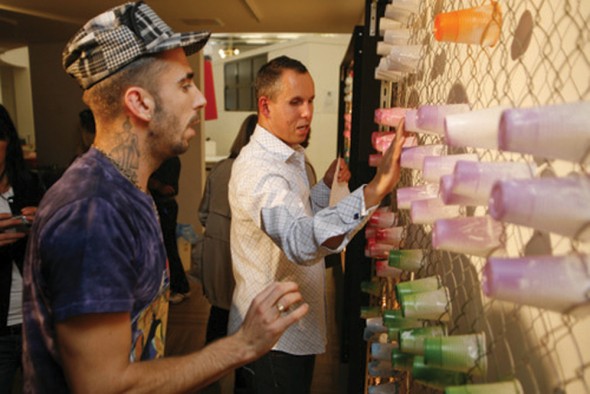
Braille bombing street aesthete Andy Uprock radically reconceives city canvassing.
Sydney-based former graffiti artist Andy Uprock has swapped spray paint and walls for cups and fences, spawning a revolutionary new street aesthetic he’s coined as “cuprocking.” His massive non-permanent street installations are arresting, provocative works of art that beautify urban landscapes, recite poetry and can even be experienced by the blind — each one technically constituting no act of vandalism.
What is “cuprocking” and when did you start it?
“Cuprocking” is the title to the method used to describe the huge floating cup installations I create with cups, aerosol cans and existing chain link fencing. I started bombing up with cups in Sydney early 2005. At the time, Sydney city was lacking in street art due to tough new laws and gentrification of the streets, and my record through graff was on its last legs, so all in all, it was a way to beautify dull public spaces without getting arrested.
Your work has received attention due to its relationship with the blind. Tell us more.
About two years ago, I discovered I could do Braille with the cups after noticing a similar pattern [to Braille] remaining after a piece had been destroyed. I did some homework and learned how to do my poetry in Braille using the cups. Since then, I’ve been working with local blind communities, organizations and people setting up Braille works. Now blind people, who have walked the same streets for the past decade, can experience tangible art in their world.
What has been the best comment you have received about this so far?
The best comment is silence. When I’ve successfully pulled of a mammoth piece (anything over 5000 cups) and seen that, even after two weeks, not one cup is down, it’s as if there has been one collective thought from the neighborhood respecting my work.
Have you had to overcome any legal obstacles with this type of art?
There’s a really grey area when it comes to authority as this art is non-permanent and can easily be removed. Cops have a hard time defining what it actually is and usually drive on by. I’ve only had one real issue and that was in Tokyo and was a result of breaking through three security barriers to get to a fence, which was above a train tunnel. That cost me one day in a Tokyo cell, which is nothing compared to the $16,000 in fines I’m still paying off from past graffiti offenses.
What’s the hardest part of creating this type of art?
The “doing” is the hardest aspect, but if you love what you do then the process is enjoyable. There has been the occasional night where I’ve set out on a mission at 2:30 a.m. and I’m only up to cup 146 and I still have 5854 cups to go. I’ve learned discipline and a wondering mind can be good company.
Where do you source inspiration?
Inspiration is like a second-hand book. As you search for it, it searches for you. As long as you’re receptive to the environment around you, it will respond back.
Where have your “cuprocking” creations appeared?
They’ve appeared on the streets of Barcelona, Paris, London, Sydney, New York, la, Tokyo, Melbourne, kl [Kuala Lumpur], Berlin and Hong Kong.
What do you hope your audience will take from your work?
Overall, appreciation is the warmest form of recognition. That’s enough for me.
Is this your day job?
My job (purpose) is to create. I live as an artist in Sydney (moving soon to Barcelona) and spend most of my days/nights painting, illustrating and making sculptures.
Where can we see more?
I have two solo painting shows mid-year in Paris and Barcelona. You can Google me or check out www.cuprocking.com to see what I’m up to.
– Fiona Killackey

